Physical Address
Minuwangoda ,Sri Lanka.
Physical Address
Minuwangoda ,Sri Lanka.
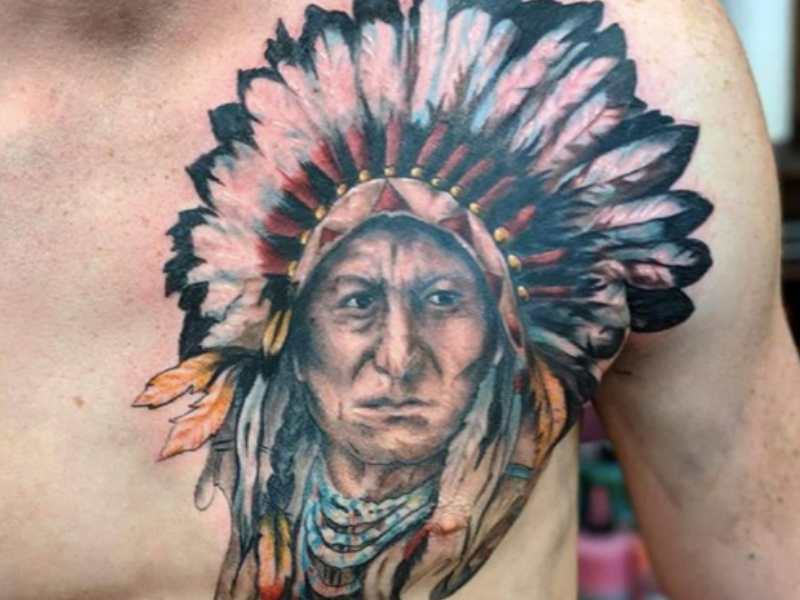
Native American tattoos are deeply embedded in the cultural and spiritual traditions of various tribes across North America. For centuries, these tattoos have served not only as personal adornments but also as significant markers of identity, status, and spiritual beliefs. Each tribe has its own unique symbols and meanings, reflecting the diversity and richness of Native American culture.
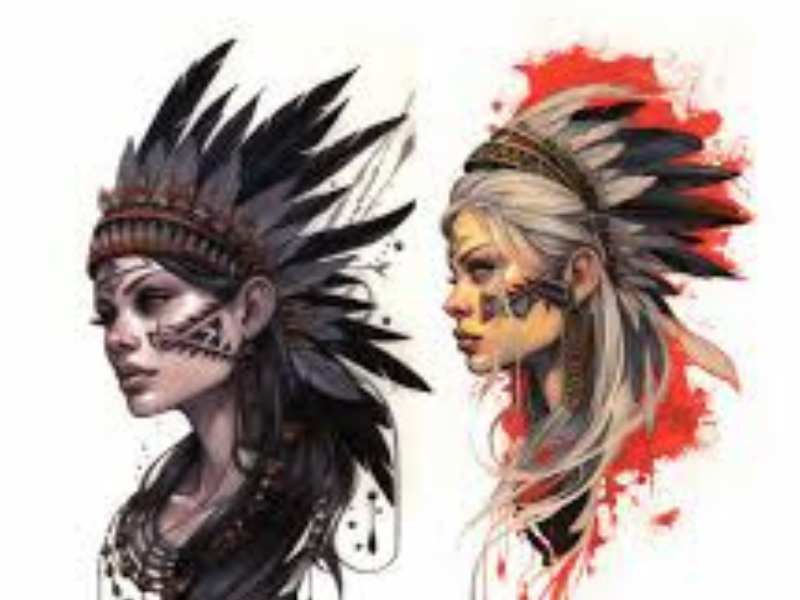
Historically, tattoos in Native American tribes were used for a variety of purposes. They often indicated social status, tribal affiliation, and personal achievements. Warriors would earn tattoos for their bravery in battle, while women might receive tattoos as rites of passage into adulthood. These markings were a way of recording important life events and accomplishments, much like a living diary inscribed on the skin.
The spiritual significance of tattoos in Native American culture cannot be overstated. Many symbols were believed to possess protective qualities, warding off evil spirits and bringing good fortune to the wearer. For instance, the Thunderbird, a common motif, was thought to control the upper world and protect against unseen dangers. The act of tattooing itself was often a sacred ritual, performed by skilled shamans or tribal elders who were believed to imbue the tattoos with spiritual power.
Traditional tattooing methods varied among tribes but commonly involved the use of natural materials. Soot or charcoal mixed with water served as the primary ink, while sharpened bones or thorns were used to puncture the skin. This process was not only a form of artistic expression but also a rite of endurance, as the pain of tattooing was seen as a test of strength and resilience.
In modern times, there has been a growing movement to revive and preserve these traditional tattooing practices. Many Native Americans are reconnecting with their heritage by choosing tattoos that reflect their cultural identity and ancestral lineage. This revival is not just about aesthetics but also about reclaiming a sense of pride and continuity with the past.
Each tattoo tells a unique story, often shared and celebrated within the community. These stories can include personal achievements, spiritual journeys, and connections to family and tribe. Tattoos serve as a visual language through which individuals communicate their personal narratives and cultural heritage.
Despite the rich tradition, Native American tattooing has faced challenges over the centuries, including suppression by colonial forces and cultural assimilation policies. However, the resilience of Native American communities has ensured the survival and resurgence of these meaningful practices. Today, there is a renewed interest in preserving and honouring the authentic techniques and symbols of Native American tattooing.
By understanding and appreciating the rich tradition of Native American tattoos, we can gain a deeper respect for the cultural and spiritual significance they hold. These tattoos are not just body art but profound expressions of identity, history, and resilience that continue to inspire and connect people across generations.
In recent years, there has been a resurgence in the appreciation and practice of Native American tattooing. Many people are rediscovering their cultural heritage through these tattoos, celebrating and preserving the rich history and meanings behind each symbol.
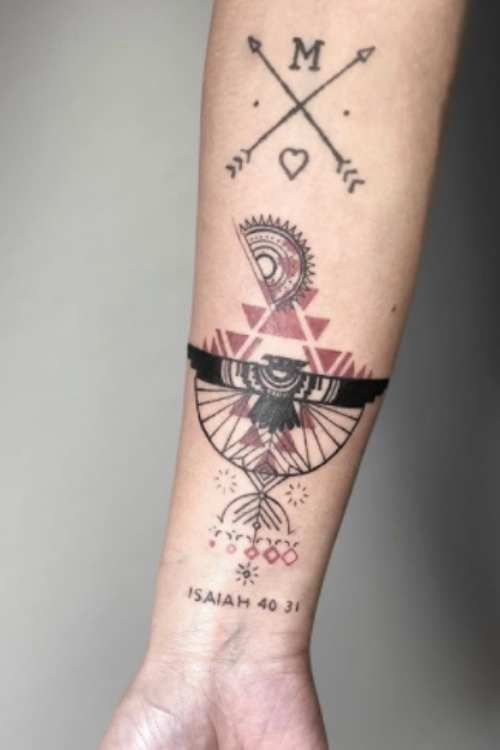
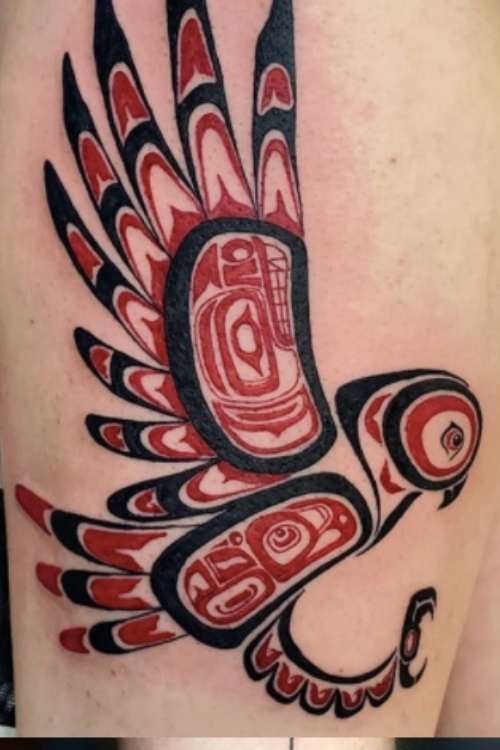
Native American tattoos are deeply personal and meaningful. Each tattoo tells a story, reflecting the wearer’s journey, values, and connection to their culture. Common symbols include animals, celestial bodies, and natural elements, each carrying specific meanings.
Native American tattoos are rich in meaning and deeply rooted in the cultural, spiritual, and social lives of the tribes. These tattoos are far more than mere decorative art; they carry profound significance and convey a wide array of messages about the wearer’s identity, experiences, and beliefs. Here’s an in-depth look at the multifaceted meanings behind Native American tattoos:
At their core, Native American tattoos are symbolic representations of personal and cultural identity. Each tattoo is chosen carefully, often with specific symbols that reflect the wearer’s heritage, tribe, and personal experiences. For example, a member of the Cherokee tribe might choose symbols that are significant within Cherokee culture, while someone from the Navajo tribe might select entirely different imagery. These symbols serve as a permanent testament to the individual’s roots and tribal affiliations.
Many Native American tattoos are imbued with spiritual meaning. They are often seen as a connection between the physical and spiritual worlds. For instance, the bear might be tattooed to invoke strength and protection, believed to be bestowed by the bear spirit. Similarly, a tattoo of a wolf might symbolize guidance and loyalty, reflecting the wearer’s spiritual journey and personal totem animal. These tattoos can serve as talismans, providing spiritual protection and guidance throughout the wearer’s life.
In many Native American cultures, tattoos are used to mark significant life events and achievements. They can signify milestones such as coming of age, marriage, or noteworthy accomplishments in hunting, warfare, or leadership. For instance, a warrior might receive a tattoo to commemorate a successful battle or a particularly courageous act. These tattoos act as a visual record of the wearer’s life story, achievements, and personal growth.
Tattoos can also denote the wearer’s social status and roles within the tribe. Different designs or placements might be reserved for leaders, warriors, shamans, or other important figures within the community. A chief might have distinct tattoos that symbolize leadership and wisdom, while a shaman’s tattoos might include symbols related to healing and spiritual guidance. These tattoos not only identify the individual’s role but also command respect and recognition from others in the tribe.
Nature is a central theme in Native American culture, and this connection is often reflected in their tattoos. Animals, plants, celestial bodies, and natural elements are common motifs, each carrying specific meanings. For example, an eagle tattoo symbolizes freedom, vision, and a high perspective, while a turtle tattoo might represent longevity, stability, and protection. These natural symbols reinforce the wearer’s deep bond with the earth and the natural world.
Tattoos serve as a living canvas for preserving tribal stories, myths, and legends. They can depict scenes from traditional narratives or embody the essence of a cultural hero or mythological figure. This form of storytelling through body art helps to keep cultural heritage alive, passing down important legends and values from one generation to the next.
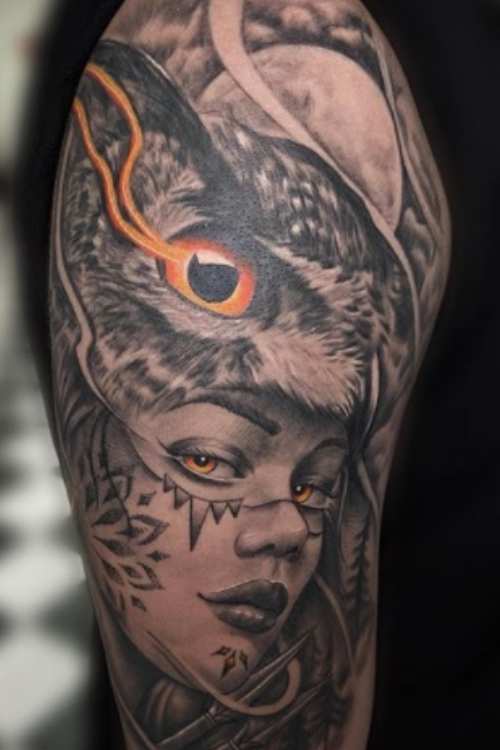
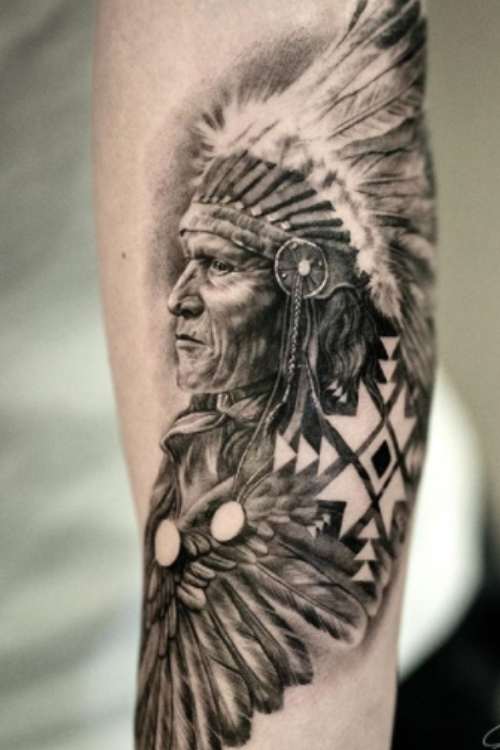
In modern times, Native American tattoos continue to evolve while retaining their traditional significance. Contemporary Native Americans often choose tattoos that honor their ancestors and heritage, while also expressing personal identity in today’s world. This blend of old and new allows for a dynamic expression of culture that resonates with both historical and modern contexts.
While rooted in tradition, Native American tattoos are also deeply personal and unique to each individual. They reflect personal choices, experiences, and interpretations of cultural symbols. The process of selecting and receiving a tattoo is often a reflective journey, during which the wearer contemplates their own identity, beliefs, and the messages they wish to convey through their body art.
Among the myriad symbols in Native American culture, the eagle stands out as one of the most powerful and revered. Its significance is deeply rooted in the spiritual and cultural traditions of many tribes across North America. The eagle’s attributes and symbolism make it a profound emblem of strength, courage, and divine connection.
The eagle is admired for its physical strength and hunting prowess. It soars high above the earth, displaying remarkable power and agility. For many Native American tribes, the eagle embodies the qualities of a warrior: strength, bravery, and resilience. Warriors often sought to emulate the eagle’s attributes, and the bird’s image was used to inspire courage and fortitude in battle. Wearing an eagle feather or having an eagle tattoo was believed to imbue the wearer with these powerful qualities.
The eagle is often considered a messenger between the earthly realm and the spiritual world. Its ability to fly at great heights brings it closer to the heavens, symbolizing a direct connection with the Great Spirit or Creator. In many Native American cultures, the eagle’s flight is seen as a bridge to the divine, making it a symbol of spiritual insight and higher vision. Shamans and spiritual leaders frequently use eagle feathers in rituals and ceremonies to facilitate communication with the spiritual realm and to invoke blessings and guidance.
Eagles are known for their keen eyesight, which allows them to see far and wide. This attribute makes the eagle a symbol of vision and clarity. It represents the ability to see beyond the immediate and gain a broader perspective on life. In Native American culture, this vision is not just physical but also spiritual, representing insight, foresight, and the wisdom to understand deeper truths. Additionally, the eagle’s majestic flight embodies the essence of freedom and the expansive possibilities of the spirit.
While the eagle holds a central place in many Native American tribes, its specific symbolism can vary. For instance:
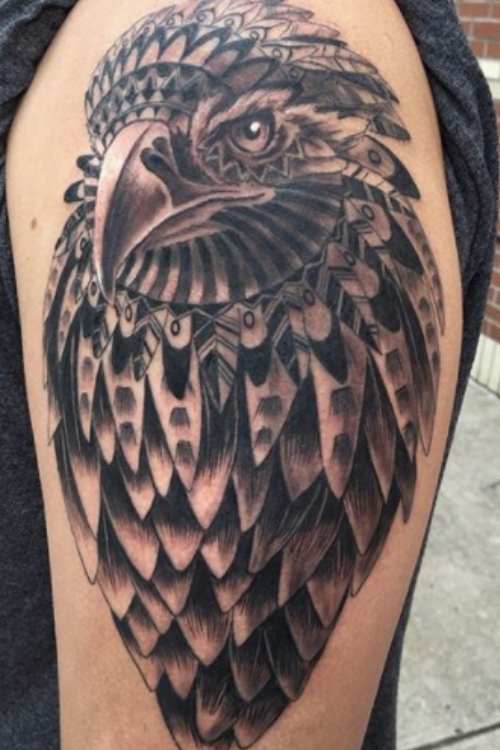
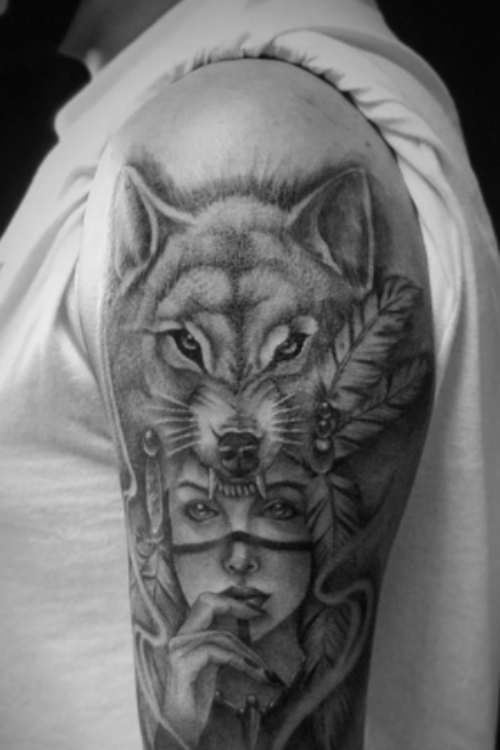
Eagle feathers hold a place of honour in many Native American ceremonies and rituals. They are used to bless new beginnings, heal the sick, and purify spaces. The feathers are often incorporated into headdresses, dance regalia, and prayer sticks. Receiving an eagle feather is considered a great honour, symbolizing respect, bravery, and a deep connection to the spiritual world.
Numerous myths and legends feature the eagle as a central character. These stories often highlight the eagle’s role as a protector and guide. For example, in some creation myths, the eagle is depicted as a guardian of the skies, watching over the people and intervening in times of need. These legends reinforce the eagle’s status as a powerful and benevolent figure within the cultural narrative.
Today, the eagle continues to be a powerful symbol for many Native Americans and others who appreciate its significance. It is a popular motif in tattoos, jewellery, and artwork, chosen for its rich symbolism and profound meanings. Modern interpretations of the eagle symbol often blend traditional beliefs with contemporary values, reflecting a dynamic and evolving cultural heritage.
Native American symbols often incorporate the four elements: earth, air, fire, and water. These elements are foundational to Native American spirituality and are used to convey balance, harmony, and the interconnectedness of life.
The four elements—earth, air, fire, and water—hold significant spiritual and cultural meanings in Native American traditions. These elements are integral to the belief systems of many tribes and are often depicted in their art, rituals, and tattoos. Each element embodies specific qualities and is associated with different aspects of life and the natural world. Understanding these elements provides a deeper insight into the holistic worldview and symbolic language of Native American cultures.
Earth is considered the sustainer and nurturer of life. It represents stability, grounding, and the physical body. In Native American symbolism, the earth is often depicted as a mother figure, providing nourishment and support to all living beings. Symbols associated with the earth include mountains, trees, plants, and animals that dwell on the land. Earth is also connected to fertility and growth, symbolizing the cycles of birth, death, and rebirth. Tattoos featuring earth symbols might include representations of animals like buffalo or bears, known for their strength and grounding presence.
Air represents the breath of life, intellect, and the unseen forces that connect all beings. It is associated with communication, freedom, and the movement of ideas. In many Native American traditions, air is seen as a conduit for spiritual messages, carrying prayers and thoughts to the heavens. Symbols of air include birds, feathers, and wind patterns. Feathers, in particular, hold a special place in Native American symbolism, often used in rituals to honour the spirits and to purify and bless spaces. A tattoo of an eagle soaring through the sky embodies the element of air, symbolizing vision, freedom, and spiritual ascent.
Fire is a powerful symbol of transformation, energy, and purification. It represents the life force, passion, and the spark of creativity. Fire is both a creator and destroyer, embodying the dual nature of life and the constant cycle of renewal. In Native American ceremonies, fire is used to purify, cleanse, and transform. The sweat lodge ceremony, for instance, employs fire to create steam, which is believed to cleanse the body and spirit. Common symbols of fire include the sun, lightning, and flames. Tattoos incorporating fire symbols might feature the sun, representing life, growth, and the vital energy that sustains all beings.
Water symbolizes emotions, intuition, and the flow of life. It is associated with healing, cleansing, and the subconscious mind. Water is a life-giving force, essential for growth and renewal. In Native American culture, water is often linked to the feminine, representing fertility, adaptability, and the nurturing aspect of nature. Symbols of water include rivers, lakes, rain, and marine animals like fish and turtles. The turtle, for example, is a common tattoo symbol representing longevity, endurance, and protection, all qualities associated with water. Water rituals, such as offerings made to rivers or lakes, are performed to honour this essential element and seek its blessings.
In Native American thought, the four elements are not separate entities but are deeply interconnected, reflecting the holistic nature of the universe. Each element complements and balances the others, creating harmony and balance in the natural world. This interconnectedness is often depicted in the medicine wheel, a sacred symbol representing the cyclical nature of life and the unity of all elements. The medicine wheel is divided into four sections, each corresponding to one of the elements, and is used in various ceremonies to promote balance and healing.
Native American tattoos often incorporate the four elements to convey a sense of balance, harmony, and connection to the natural world. A tattoo design might blend earth, air, fire, and water symbols to create a comprehensive narrative about the wearer’s beliefs, experiences, and values. For example, a tattoo featuring a bear (earth), an eagle (air), the sun (fire), and a river (water) would represent the wearer’s deep connection to all aspects of nature and their desire for balance and harmony in life.
Today, the symbolism of the four elements continues to inspire and guide those who seek to connect with their Native American heritage or find deeper meaning in their lives. Modern interpretations of these symbols can be seen in various forms of art, jewellery, and personal adornments like tattoos. They serve as a reminder of the enduring wisdom of Native American cultures and the importance of living in harmony with the natural world.
In Native American culture, the sun is widely regarded as a symbol of happiness. This celestial body, which provides light and warmth, holds profound significance across various tribes. It represents not just physical sustenance but also spiritual enlightenment and joy. Here’s an expanded exploration of the sun’s symbolism and other symbols associated with happiness in Native American culture:
The sun is essential for life, promoting growth and vitality in all living things. It symbolizes the life-giving force that sustains the earth and its inhabitants. For many Native American tribes, the sun’s rising and setting each day are seen as powerful symbols of renewal and the perpetual cycle of life. The warmth and light it provides are associated with joy, positivity, and the nurturing aspects of the natural world.
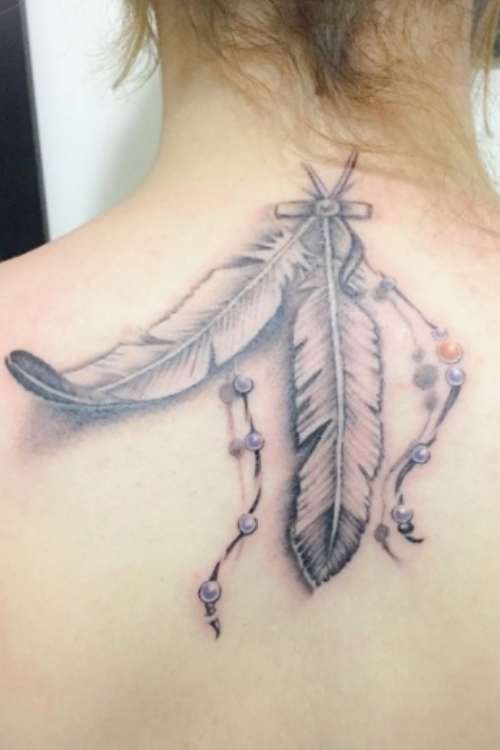
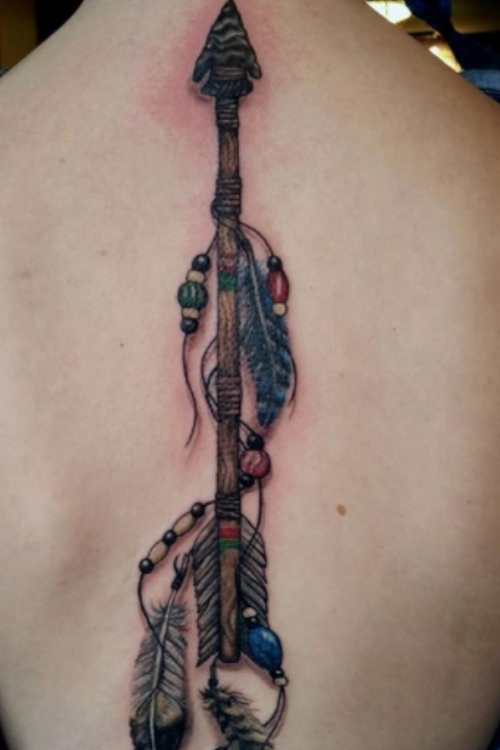
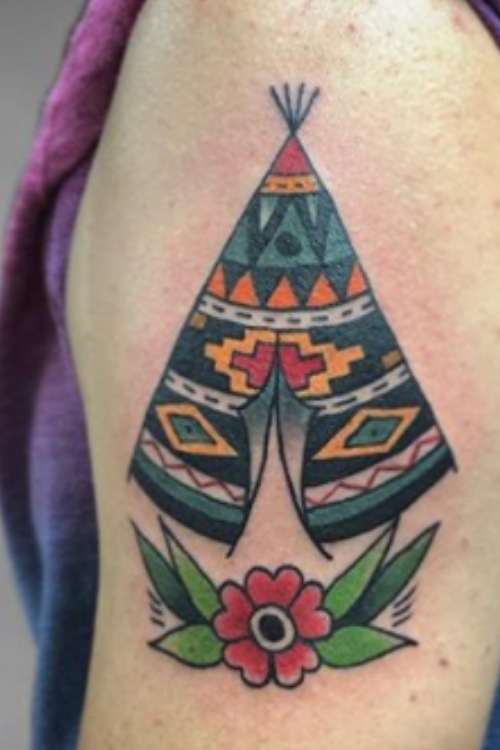
The Native American healing symbol is rich with meanings that reflect the deep spiritual and holistic approach to health and well-being inherent in indigenous cultures. One of the most recognized symbols associated with healing is the Medicine Wheel. This sacred symbol encapsulates the philosophy of balance, harmony, and interconnectedness that is central to Native American healing practices.
The Medicine Wheel, also known as the Sacred Hoop, is a potent symbol used in various tribes to represent the cyclical nature of life and the interconnectedness of all things. It is a tool for teaching and healing, embodying the core principles of Native American spirituality.
Native American cultures are rich with animal symbols, each carrying unique meanings and spiritual significance. These symbols are deeply intertwined with the beliefs, traditions, and daily lives of various tribes, representing qualities, messages, and lessons from the natural world. Animals are seen as guides, protectors, and embodiments of particular virtues or powers. Here’s an expanded exploration of some key Native American animal symbols and their meanings:
The placement of a tattoo is significant in Native American culture. For example:
Choosing a Native American tattoo involves considering the symbolism that resonates with you. Here are some ideas:
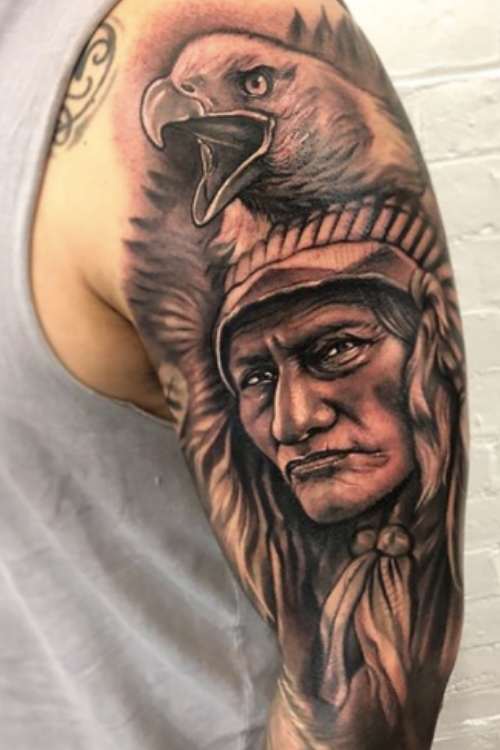
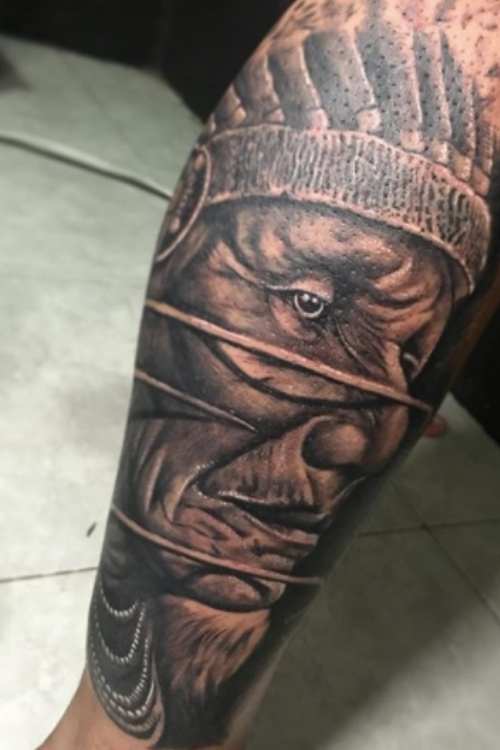
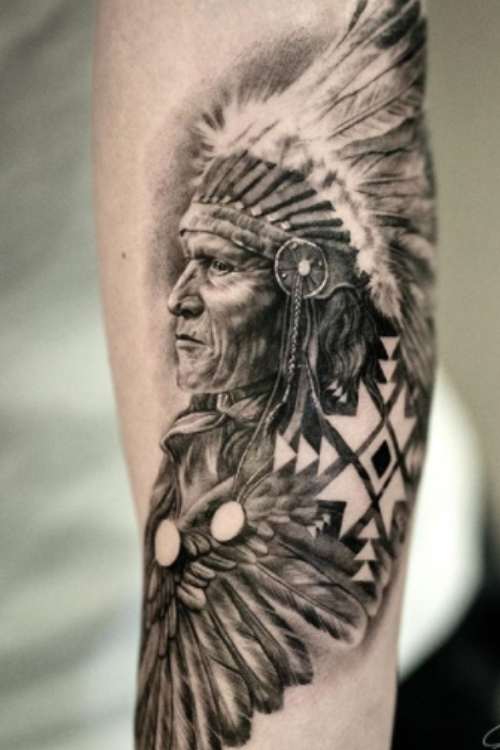
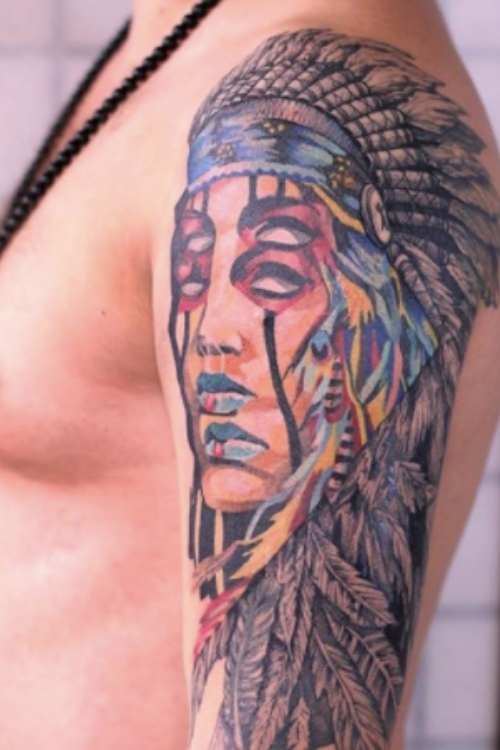
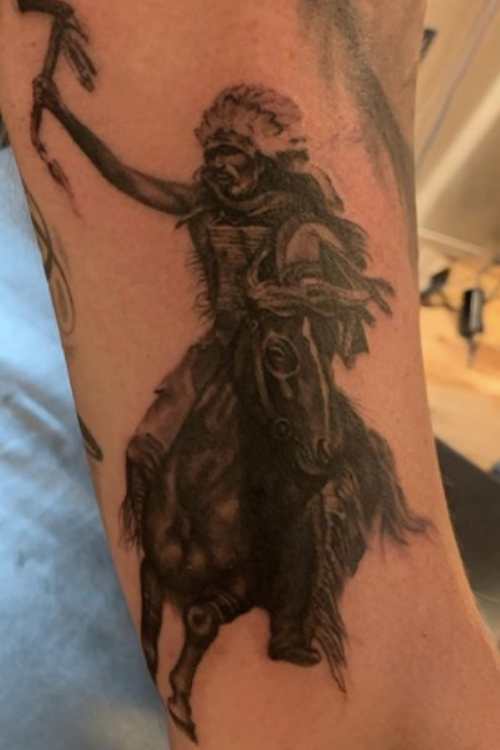
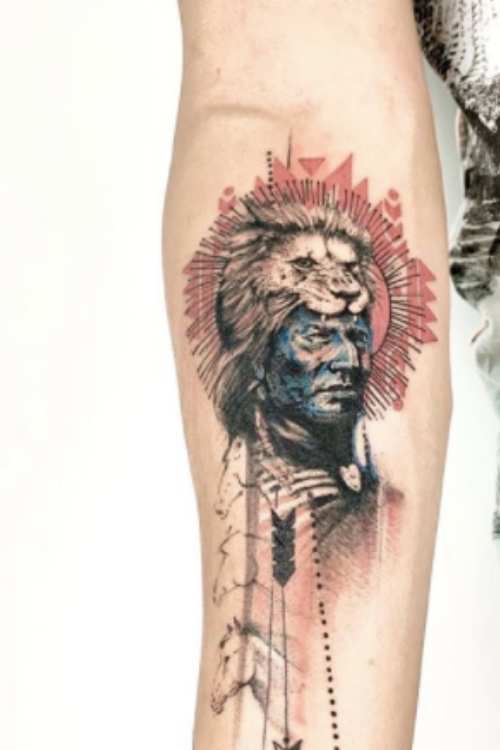
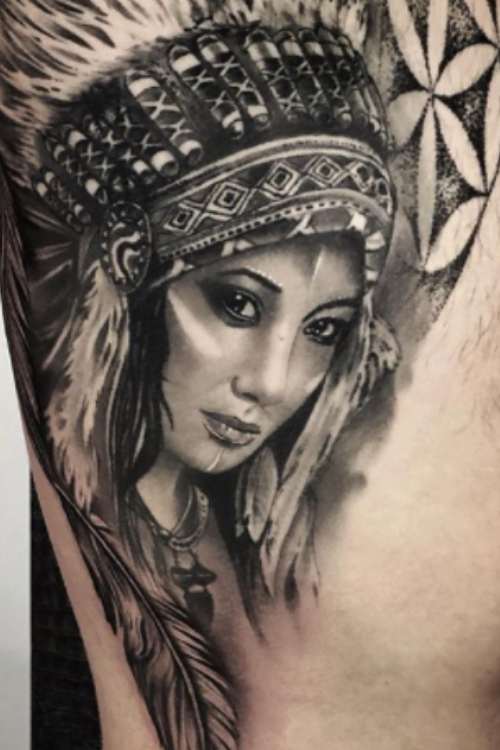


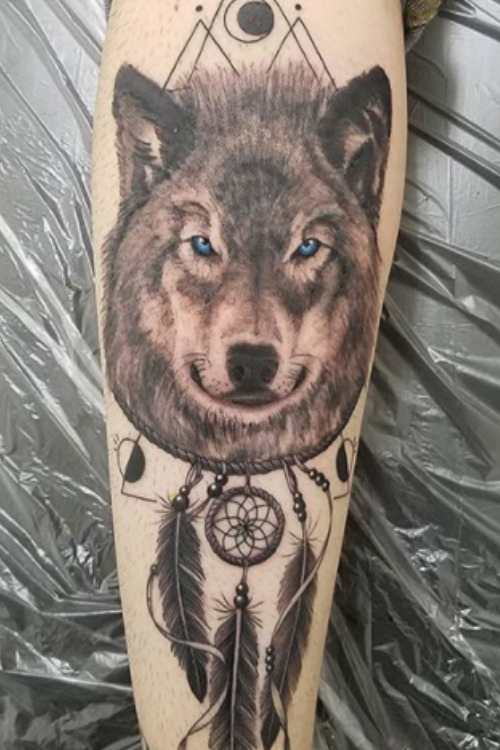
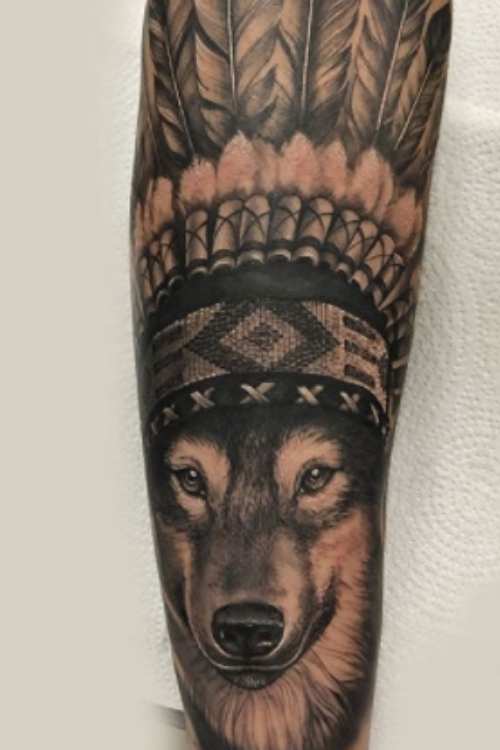

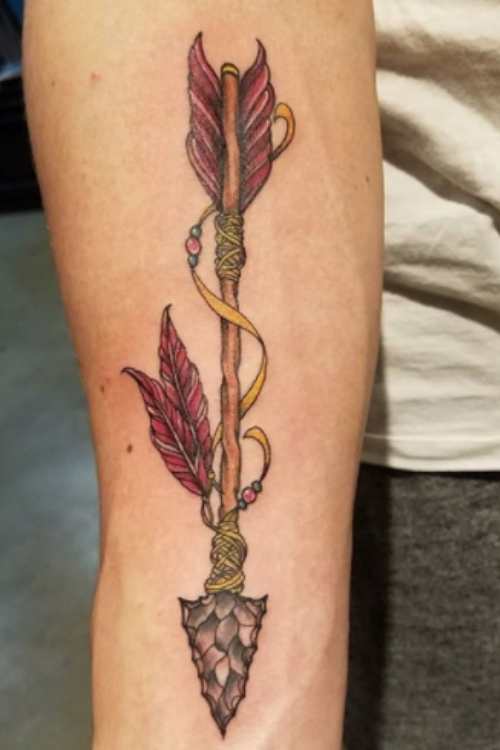
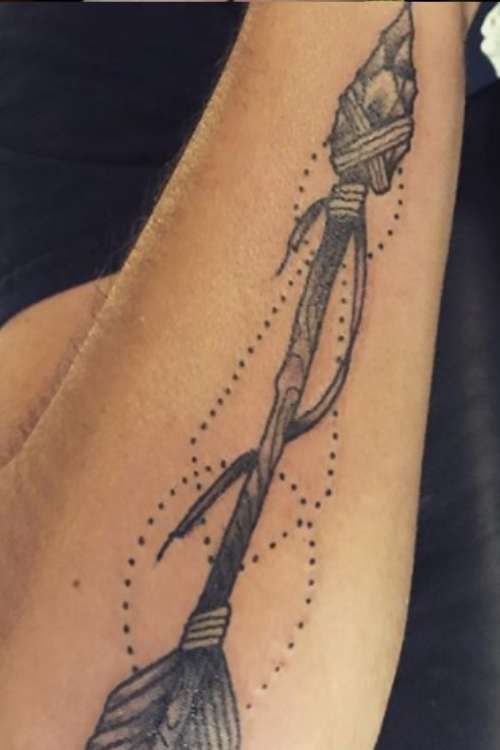


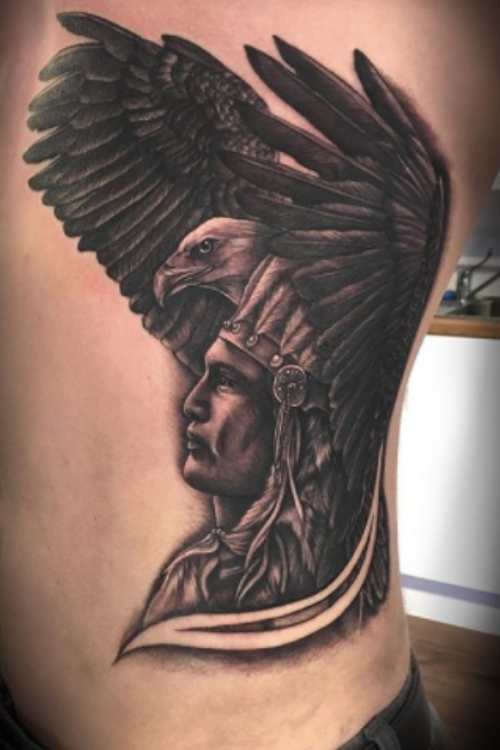
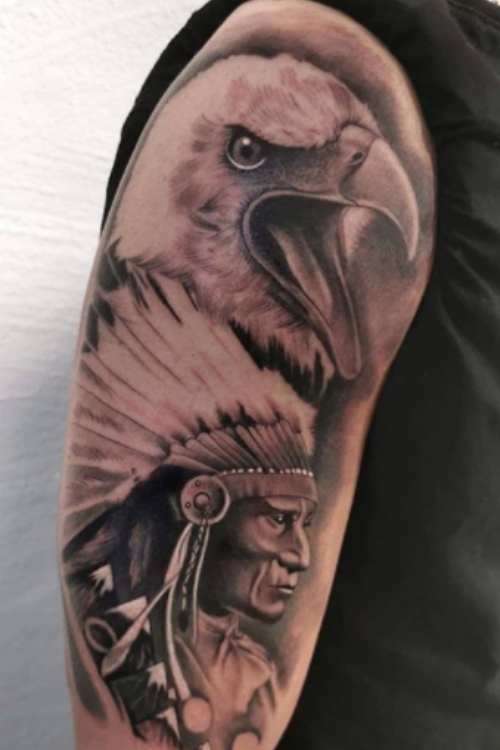
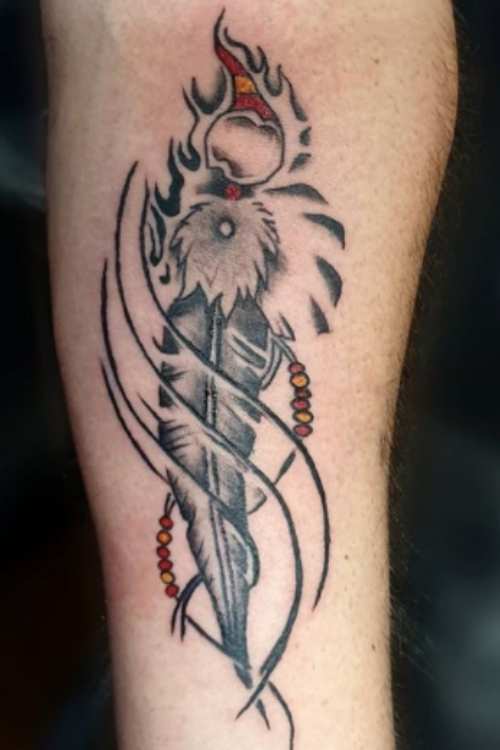
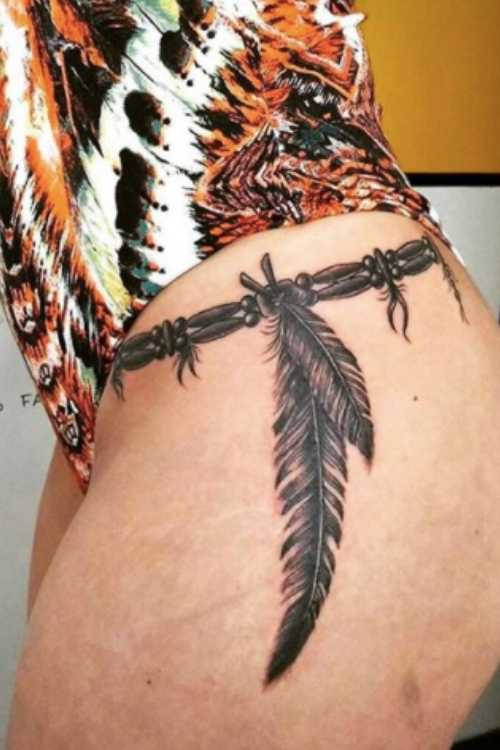

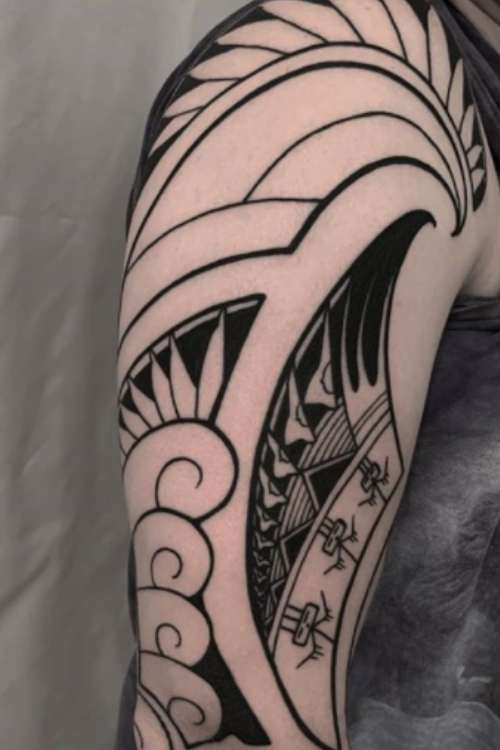
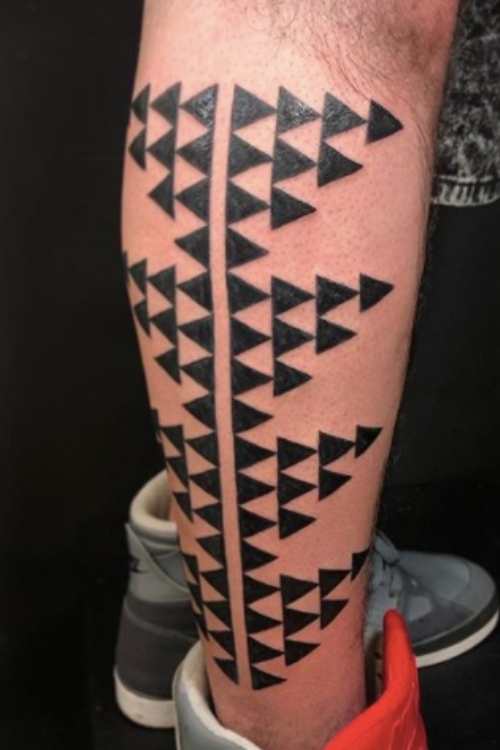

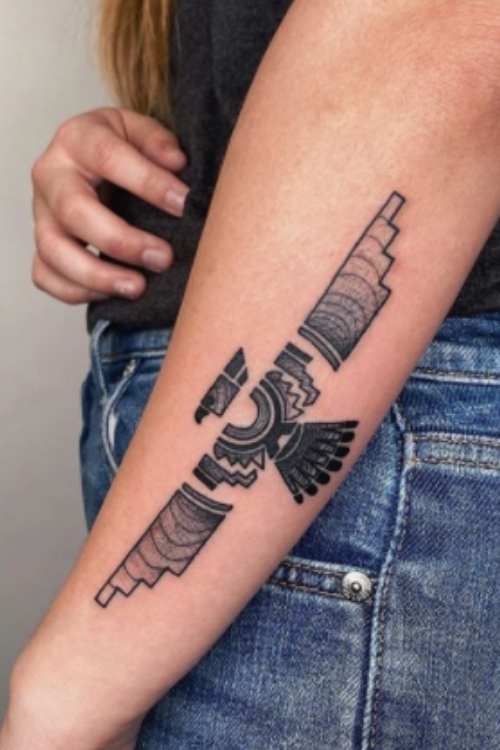
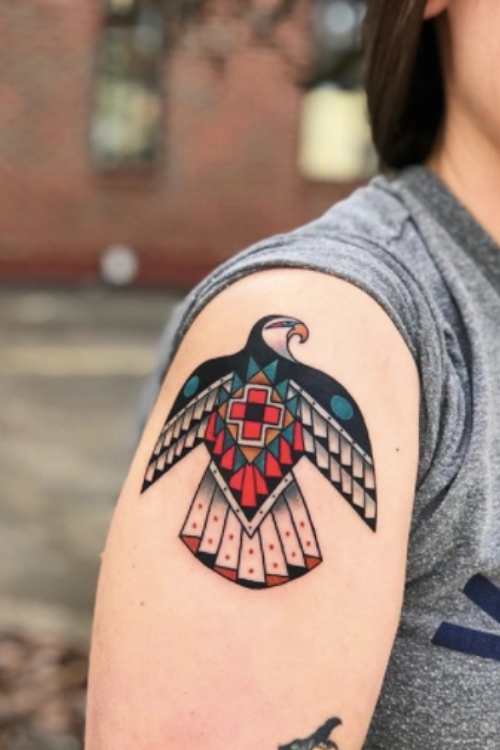

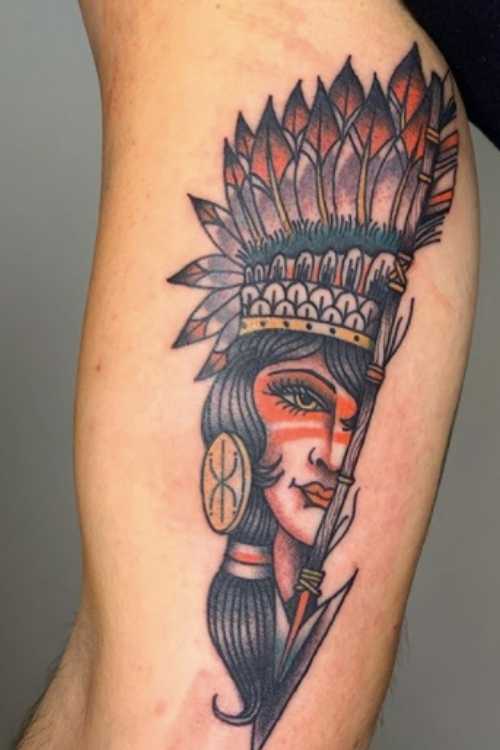
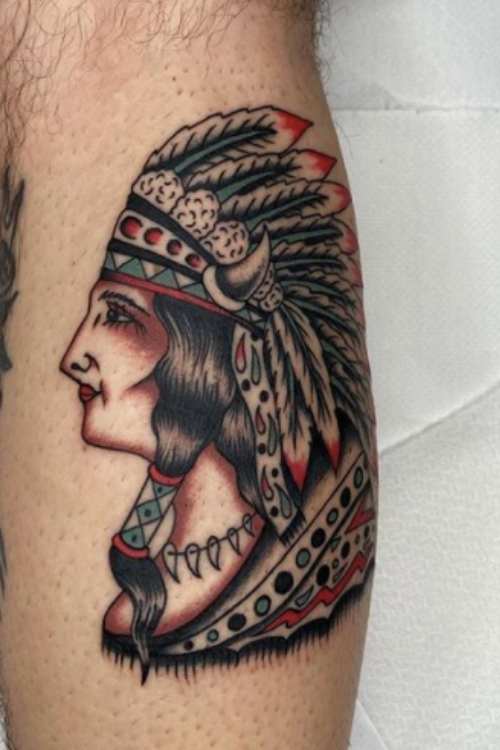

Headdress tattoos are powerful symbols of leadership and respect. They are often detailed and intricate, representing the honour and responsibility of a chief.
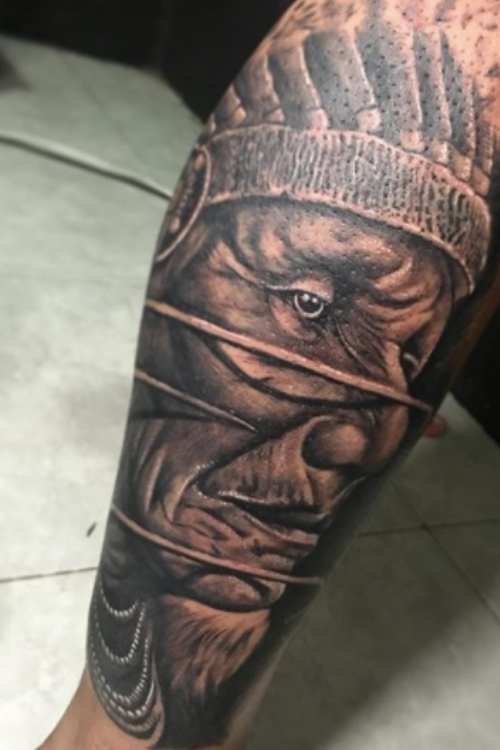

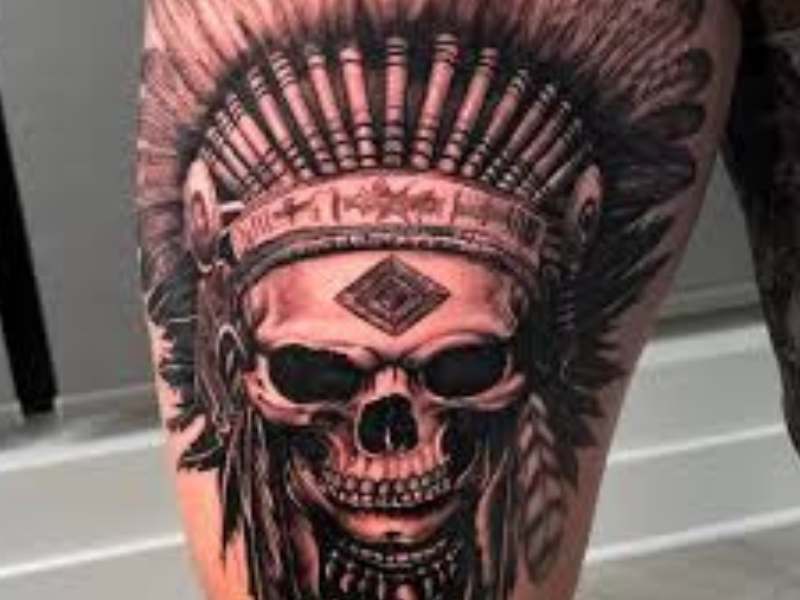
Consider the meaning and visibility of your tattoo when choosing its placement. Common spots include:
The cost of a Native American tattoo can vary based on the complexity and size of the design. Detailed tattoos like full sleeves or intricate symbols may range from $200 to $1000 or more. Always consult with a professional tattoo artist to get an accurate estimate.
Native American tattoos are more than just body art; they are a profound expression of cultural identity and personal beliefs. By understanding and appreciating the meanings behind these symbols, we can honour the rich traditions and stories they carry. Whether you choose a traditional design or a modern interpretation, a Native American tattoo can be a powerful symbol of your journey and values.